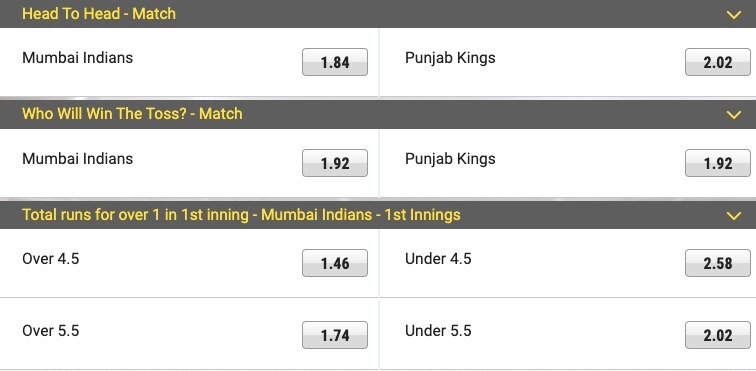While punters think that the bookmaker is losing money when their bet wins, it is far from the truth.
In reality, bookmakers make money regardless of who wins or loses.
Bookmakers, relying on some clever tactics, set their odds in a way that their profits stay intact irrespective of the outcome of the event.
Here is how they do it.
How do bookmakers set odds?
The first step in setting odds is to correctly determine the outcome of an event and add their profit margin to it. Different bookmakers operate with different profit margins.
To understand better, let’s take a cricket match between India and Australia as an example.
The probability of either team winning the toss is 50-50 and the odds given by the bookmaker are 1.90 for both teams.
Now consider two bettors, with INR 100 each, and the first one bets on India winning the toss and the second on Australia winning it.
If India wins, the first bettor would get INR 190, while the second would lose INR 100.
The sum that was actually wagered before the toss was INR 200 (100 + 100) but the pay out was INR 190. In this case, the bookmaker kept the missing INR 10 or five per cent, which is their profit margin.
By setting odds in such a way, the bookmaker would have made money even if Australia would have won the toss.
However, in a real-world scenario, there can be 1000s of people betting on India while only 100 would bet on Australia.
If India was to win the toss, the bookmaker would have to shell out a lot more money since the money wagered on Australia would be too less to cover up the winnings of players.
To offset such risks and protect their profit margins, bookmakers will bump up the odds of Australia, raising it to let’s say 8.5 and simultaneously lower the odds of India to maybe 1.20.
This will drive people to bet on Australia since the returns would be higher.
In reality, bookmakers try to balance their books by constantly changing the odds, depending on the pattern of bets being placed.
Such varying of odds goes on throughout a match.
Let’s take another example to fully know how bookmakers set odds.
This time, consider a cricket match between England and Zimbabwe.
The probability of England triumphing is 80 per cent while Zimbabwe’s is 20 per cent.
This was determined by studying previous results, stadium records, players’ form, home or away advantage and several other factors.
While setting odds, the bookmaker will add their five per cent profit margin, showing users an 85 per cent chance of England winning and a 25 per cent chance for Zimbabwe.
The odds would also be set in a way that the profit margin is intact and would look like 1.17 for England and 4.5 for Zimbabwe.
Let’s assume, 80 people bet INR 10 each on England and 20 punt INR 10 each on Zimbabwe.
The total amount wagered would be INR 1000 (800 + 200).
If England win, the bookmaker will pay INR 11.7 (initial stake of 10 + 1.17 winnings) to 80 bettors, amounting to INR 936.
Since 20 bettors also lost INR 10 each, the bookmaker would make INR 200 from them.
So, the profit of the bookmaker would be INR 64 (1000 – 936)
If Zimbabwe end up winning, the bookmaker will pay INR 45 (initial stake of 10 + 35 winnings) to 20 bettors, amounting to 900.
Here, the bookmaker’s profit would be INR 100 (1000 – 900).
Irrespective of the result, the bookmaker makes money.
Bookmakers use sophisticated algorithms to spontaneously change the odds to keep in line with their margins.
